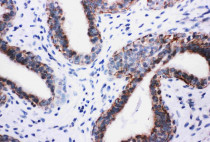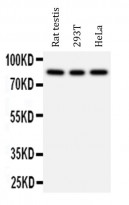ARG40830
anti-PI3 Kinase p85 beta antibody
anti-PI3 Kinase p85 beta antibody for IHC-Formalin-fixed paraffin-embedded sections,Western blot and Human,Mouse,Rat
Overview
| Product Description | Rabbit Polyclonal antibody recognizes PI3 Kinase p85 beta |
|---|---|
| Tested Reactivity | Hu, Ms, Rat |
| Predict Reactivity | Hm |
| Tested Application | IHC-P, WB |
| Host | Rabbit |
| Clonality | Polyclonal |
| Isotype | IgG |
| Target Name | PI3 Kinase p85 beta |
| Antigen Species | Human |
| Immunogen | Synthetic peptide corresponding to aa. 447-461 of Human PI3 Kinase p85 beta. (KVYHQQYQDKSREYD) |
| Conjugation | Un-conjugated |
| Alternate Names | P85B; Phosphatidylinositol 3-kinase 85 kDa regulatory subunit beta; PtdIns-3-kinase regulatory subunit beta; PI3-kinase regulatory subunit beta; p85; PI3K regulatory subunit beta; MPPH1; MPPH; Phosphatidylinositol 3-kinase regulatory subunit beta; PtdIns-3-kinase regulatory subunit p85-beta; p85-BETA; PI3-kinase subunit p85-beta |
Application Instructions
| Application Suggestion |
|
||||||
|---|---|---|---|---|---|---|---|
| Application Note | IHC-P: Antigen Retrieval: Heat mediation was performed in Citrate buffer (pH 6.0, epitope retrieval solution) for 20 min. * The dilutions indicate recommended starting dilutions and the optimal dilutions or concentrations should be determined by the scientist. |
Properties
| Form | Liquid |
|---|---|
| Purification | Affinity purification with immunogen. |
| Buffer | 0.2% Na2HPO4, 0.9% NaCl, 0.05% Thimerosal, 0.05% Sodium azide and 5% BSA. |
| Preservative | 0.05% Thimerosal and 0.05% Sodium azide |
| Stabilizer | 5% BSA |
| Concentration | 0.5 mg/ml |
| Storage Instruction | For continuous use, store undiluted antibody at 2-8°C for up to a week. For long-term storage, aliquot and store at -20°C or below. Storage in frost free freezers is not recommended. Avoid repeated freeze/thaw cycles. Suggest spin the vial prior to opening. The antibody solution should be gently mixed before use. |
| Note | For laboratory research only, not for drug, diagnostic or other use. |
Bioinformation
| Database Links |
Swiss-port # O00459 Human Phosphatidylinositol 3-kinase regulatory subunit beta Swiss-port # O08908 Mouse Phosphatidylinositol 3-kinase regulatory subunit beta |
|---|---|
| Gene Symbol | PIK3R2 |
| Gene Full Name | phosphoinositide-3-kinase, regulatory subunit 2 (beta) |
| Background | Phosphatidylinositol 3-kinase (PI3K) is a lipid kinase that phosphorylates phosphatidylinositol and similar compounds, creating second messengers important in growth signaling pathways. PI3K functions as a heterodimer of a regulatory and a catalytic subunit. The protein encoded by this gene is a regulatory component of PI3K. Two transcript variants, one protein coding and the other non-protein coding, have been found for this gene. [provided by RefSeq, Dec 2012] |
| Function | Regulatory subunit of phosphoinositide-3-kinase (PI3K), a kinase that phosphorylates PtdIns(4,5)P2 (Phosphatidylinositol 4,5-bisphosphate) to generate phosphatidylinositol 3,4,5-trisphosphate (PIP3). PIP3 plays a key role by recruiting PH domain-containing proteins to the membrane, including AKT1 and PDPK1, activating signaling cascades involved in cell growth, survival, proliferation, motility and morphology. Binds to activated (phosphorylated) protein-tyrosine kinases, through its SH2 domain, and acts as an adapter, mediating the association of the p110 catalytic unit to the plasma membrane. Indirectly regulates autophagy. Promotes nuclear translocation of XBP1 isoform 2 in a ER stress- and/or insulin-dependent manner during metabolic overloading in the liver and hence plays a role in glucose tolerance improvement (By similarity). [UniProt] |
| Calculated MW | 82 kDa |
| PTM | Phosphorylated in response to signaling from activated receptor-type protein kinases (PubMed:19690332, PubMed:20068231). Dephosphorylated by PTPRJ (PubMed:18348712). Dephosphorylated at Tyr-655 by PTPN13. Phosphorylation of Tyr-655 impairs while its dephosphorylation promotes interaction with FBXL2 and SCF(FBXL2)-mediated polyubiquitination (PubMed:23604317). Ubiquitinated. Polyubiquitination by the SCF(FBXL2) complex probably promotes proteasomal degradation of PIK3R2. [UniProt] |
Images (3) Click the Picture to Zoom In
-
ARG40830 anti-PI3 Kinase p85 beta antibody IHC-P image
Immunohistochemistry: Paraffin-embedded Human mammary cancer tissue. Antigen Retrieval: Heat mediation was performed in Citrate buffer (pH 6.0, epitope retrieval solution) for 20 min. The tissue section was blocked with 10% goat serum. The tissue section was then stained with ARG40830 anti-PI3 Kinase p85 beta antibody at 1 µg/ml, overnight at 4°C.
-
ARG40830 anti-PI3 Kinase p85 beta antibody WB image
Western blot: 50 µg of samples under reducing conditions. Rat testis, 293T and HeLa whole cell lysates stained with ARG40830 anti-PI3 Kinase p85 beta antibody at 0.5 µg/ml, overnight at 4°C.
-
ARG40830 anti-PI3 Kinase p85 beta antibody WB image
Western blot: 50 µg of samples under reducing conditions. Mouse liver and Mouse brain tissue lysates stained with ARG40830 anti-PI3 Kinase p85 beta antibody at 0.5 µg/ml, overnight at 4°C.








